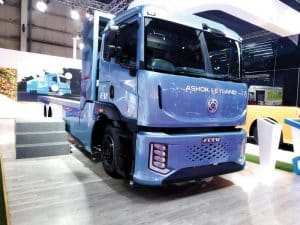Ashok Leyland Ltd. wound up a year-long strategy to address customer requirements with the display at the Auto Expo 2023- The Motor Show. Finding ways to stay profitable and minimise the pressures of operating margins, the Hinduja Group company showcased a total of seven mobility solutions including options in Battery Electric Vehicles (BEVs) and the hydrogen platform. It showcased the Fuel Cell Electric Vehicle (H2-FCEV), Hydrogen Internal Combustion Engine (H2-ICE) vehicle, Liquified Natural Gas (LNG) solution, an intercity Compressed Natural Gas (CNG) coach, and a mini passenger bus on the Dost platform that drew second looks courtesy an established cargo hauling DNA. Dheeraj Hinduja, Executive Chairman, of Ashok Leyland Ltd., stated, “Through this futuristic and innovative product portfolio, we have once again demonstrated our technological leadership, and more importantly our commitment to the clean mobility mission. The range of our new clean-energy products, covering both the truck and bus segments, underscores our capability and readiness to lead the transformation in the road transportation sector.” He committed to remaining deeply invested in the cause of sustainability, aspiring to lead the market with new-generation commercial vehicles.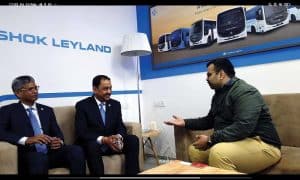
Taking the podium, and slipping into his new role with aplomb, Managing Director and Chief Executive Officer, Shenu Agarwal put forth his views. He averred, “The automotive sector has seen a wave of technological upgrades in the last two years with green fuel being the future of the industry. Having one of the best R&D teams in the country, we want to continue our path to innovate and leverage new technology to be a leader in sustainable and environment-friendly mobility.” He shared, the OEM aims to make the alternate fuel segment self-reliant as one of the flag bearers of the ‘Atmanirbhar Bharat’ campaign. To achieve this, he stressed the need to be agile to tap into market opportunities that come by with a digital mindset and a customer-centric approach. The fabric of Ashok Leyland has embodied this over the years, he exclaimed.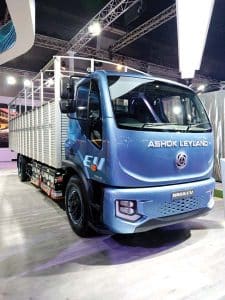
In an exclusive chat, he mentioned that the current fiscal looked promising. He credited the government at the centre for its long-term impetus on infra structural development which is proving to be a significant tailwind for the company. He cited favourable conditions over the next two- to three years. “Ashok Leyland has been able to recover its market share very fast and hopefully we will attain our best market share ever very soon too,” he expressed. Hailing the current times as exciting for the company and the industry as a whole, he admitted that the energy levels at the company are at their peak. He credited the mix of products and services for being able to recover the lost market share.
Sanjeev Kumar, Business Head – M&HCV at the company also cited tailwinds working in favour of the company. Admitting to the slower pace of scaling up CNG products when it was first introduced into the market, having lagged more than the company expected, he shared that the company had taken the learnings along. “We are clear this time round that we will be ready with all the technologies this time around,” he asserted. The company is confident of being in a position to improve its presence across geographies like the North (~33-34 per cent contribution to total volumes at the company in comparison to 21-22 per cent from the South) and the East. North East together accounts for ~60-65 per cent plus for the company as a testimony to growing acceptance in its satellite markets which continues to be a strong focus area for the company. He expressed hope in the India consumption subject to supply-chains expected to support the projections. Kumar cited the example of advanced markets like the US and China that went through a similar churn over three decades.
He drew attention to the delivery of 29 H2-FCVs in partnership with Reliance Group, he shared how the company was working on small proof of concepts with its customers. He cited the AVTR platform as the core to this strategy which allows to retain the basic geometric and structural integrity of the vehicles as the base of a modular approach. He hailed the latest developments as a culmination of a rigorous three-year exercise with each stakeholder including partner suppliers playing their part. While the adoption level has improved, he said the team was working to attain Economies of Scale (EoS) to get the costing right with domestic capacities aligned to it. The average order size has gone up sizeably, he shared pointing at the growing preference of high-tonnage vehicles consistently with traction in the tipper and Multi-Axle Vehicles (MAVs) driven by the need to move several aggregates like coal and iron,ore etc. Tractor Heads are also gaining traction, he shared.
Dr N Saravanan, President, and Chief Technology Officer, of Ashok Leyland Ltd., mentioned that there are several drive train permutations and combinations today to pursue the end goal of carbon neutrality that the company is working on. “We have the prowess on technology with an in-house capability on diesel, CNG, LNG, and H2ICE. We are demonstrating our capabilities across segments for the benefit of our customers.” He spoke highly of the modular approach that paves the way for using the same base platform and scaling it up to meet the duty cycles of different customer use cases. “The credit for our quick development cycles goes to our AVTR platform. We did not envision the transition to take place so soon but we had a plan in place for the industry shifting beyond diesel to so many alternatives which we have been able to press into action,” he explained. We expect to be ahead of the curve in terms of time to market, going forward, he stated.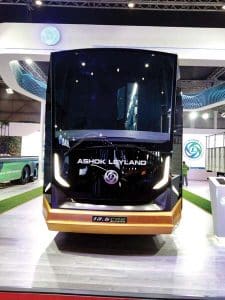
On services, the company is looking to customise telematic applications with specific User Interfaces (UI) for meeting customer needs. He admitted to it being a tipping point as well. Admitting to the challenges en route to monetisation, going forward, he added, the company was confident of convincing customers on showing a tangible improvement on a metric like improving fuel economics or procuring spares at a lower cost as examples. On pursuing technological parity among domestic and export interests, and commercial and defence applications, the company is claimed to have been able to reduce complexities and able to juggle the needs of zero emissions compliance to emission six levels in a vast demographic. It is closely watching the varied requirements and working towards meeting them on a case-to-case basis as per Dr Sarvanan. With similar challenges for OEMs across the globe, it’s the ability to tap into an opportunity that will set one OEM apart from the other, he opined.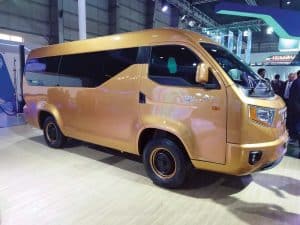 The OEM drew attention to a 75-year-old legacy, and how the company had succeeded in building a pan-India service network with 24×7 support, and in-house development capabilities. Building on it, the manufacturer aims to expand product lines and in turn expand its presence in the fast-growing alternate fuel segment. In the BEV segment, Ashok Leyland displayed the Boss BEV aimed at green mobility requirements. Powered by a Lithium-ion battery pack, the company has optimised the architecture to minimise the impact of battery pack weight eating into the payload. The company is claimed to have cracked a lightweight build. Its Hydrogen FCEV, has the fuel cell atmospheric oxygen along with hydrogen to produce electricity. This in turn charges the power electronics and the motor that further drives the vehicle. The inclusion of a Lithium-ion battery pack coupled with an external charging provision allows the vehicle to operate on a limited electric range as the backup. To ensure high safety level on board, the company has made provision for a leak detection system.
The OEM drew attention to a 75-year-old legacy, and how the company had succeeded in building a pan-India service network with 24×7 support, and in-house development capabilities. Building on it, the manufacturer aims to expand product lines and in turn expand its presence in the fast-growing alternate fuel segment. In the BEV segment, Ashok Leyland displayed the Boss BEV aimed at green mobility requirements. Powered by a Lithium-ion battery pack, the company has optimised the architecture to minimise the impact of battery pack weight eating into the payload. The company is claimed to have cracked a lightweight build. Its Hydrogen FCEV, has the fuel cell atmospheric oxygen along with hydrogen to produce electricity. This in turn charges the power electronics and the motor that further drives the vehicle. The inclusion of a Lithium-ion battery pack coupled with an external charging provision allows the vehicle to operate on a limited electric range as the backup. To ensure high safety level on board, the company has made provision for a leak detection system.
The flavour of the auto expo (H2-ICE) had the company leverage its partnership with RIL. Akin to conventional combustion engines, the company is known to have made only a few tweaks to have it run on hydrogen. The vehicle comes with L2-Advanced Driver Assistant System (ADAS) to meet the needs of enhanced vehicle and road safety. Having launched an LNG truck last year (2022), the company upped the ante with a dual-fuel vehicle, LNG and CNG hybrid. The architecture of the truck ensures the natural gas is super-cooled and cryogenically stored in liquid form in a tank mounted on the truck in line with the growing demand for LNG in the long-haulage HD trucks offering 1000 km range on a single fill. All of these products are derived from the AVTR modular vehicle platform with a high degree of sub-aggregates commonality with the company’s diesel range in an attempt to offer higher performance reliability. With an ability to smoothly transition to the Realworld Driving Emission (RDE) emission norms (BSVI-phase two), the company has planned. It is closely watching the Euro7 compliance norms and how they will be translated into the Indian context. The company expects it to be rolled out between 2027-29 subject to regulatory requirements.
On its unique positioning credited to sister company Albonair, Dr Sarvanan informed, that the learnings from the latter’s experience of working with EU OEMs hold it in good stead. In the people mover range the 4×2 13.5m Intercity CNG bus attracted onlookers. Positioned as the longest bus in the growing segment, the company claims to have fitted the most powerful turbocharged CNG engine. About 1500-litre (255 kg) of CNG is stored in lightweight composite cylinders said to have been safely mounted over the frame. This is claimed to give the bus an approximate 1000 kms range. The bus is built to offer maximised luggage space of 11 Cu. m., claimed to be the highest among the CNG buses. It also offers a 20 per cent higher passenger capacity with 36 berths, a segment high as per company claims.
Drawing from the DNA of the Bada Dost, the company showcased the Bada Dost Xpress that runs on CNG too. A mini passenger bus, its engine is tuned for both city and highway driving. The ergonomic design has room to seat 12 passengers with special attention paid to easy ingress and egress. Inclusions like the grab rails, safety handles, and anti-skidding flooring stood out. The vehicle will be offered with AC (optional) and Vehicle Tracking System (VTS). The company is also gearing to build an ecosystem around its product while hoping to bring the supporting infrastructure like lane markings to be able to scale up the adoption of tech like lane-departure assist, L1-L2 ADAS etc. It could foray into niche applications with these over waiting for the entire ecosystem to be built for rollout.



